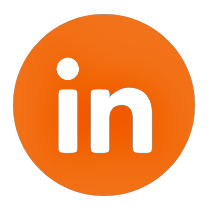 It’s a huge opportunity. You’ve spent hours and hours preparing to deliver a presentation at your industry conference. Will this set you up as an expert and lead to lots of business opportunities? Or will this just be a big time-suck that distracts you from other important work tasks?
It’s a huge opportunity. You’ve spent hours and hours preparing to deliver a presentation at your industry conference. Will this set you up as an expert and lead to lots of business opportunities? Or will this just be a big time-suck that distracts you from other important work tasks?
The answer to these questions lies completely in your hands. Will you seize the opportunity or will you bemoan that nothing really developed from your performance on the platform?
I’ve actually worked with some clients who were frequent presenters who complained that, despite their best efforts, no new business activity ever came out of their presentations. And they couldn’t really understand why. To hear them share their experience, it would appear that they were subject-matter experts who deftly used humor and content to entertain and inform their audiences. What more could they do?
Before I share some sure-fire ways to have the audience begging for more, let’s cover the first rule of effective presentations. Prepare and practice. The best presenters are the most prepared. They not only are content experts, but they are on-point. They are engaging and polished and they know how to share information in a way that is relevant and interesting to their audience. In fact, I would venture to claim that “winging it” is not in their vocabulary.
So I will start with the premise that you are prepared and you have practiced so that you can deliver a knock-out performance. Because if you fall short with the delivery or the content, you are not going to be able to capitalize on any speaking opportunity.
Here are five things you can do to set yourself apart and have your audience clamoring to talk to you after your presentation:
1. Get To Know Your Audience & Their Challenges – It’s very easy as an expert to assume that you understand the challenges and situations that are common to your audience. A good presenter will have a detailed discussion with the event or group contact to ask the right questions. But how can you take it to the next level? My favorite method is something that is rarely done by other speakers and it helps me stand out from the crowd. I simply ask the event organizer if I can talk to several of the members of the group or people attending the event so I can more fully customize my presentation. It’s usually other movers and shakers who are well-known by my contact person. Then I contact these folks and ask for a chance to do a brief phone interview with them.
This is pure gold for a number of reasons. First, they are flattered to be sought out for their insights, so you’ve made an instant friend and ally. Second, they really have great stories or information to share that will help you zero in on the most interesting and compelling information so you can knock your presentation out of the proverbial park. Third, you have your allies in the audience during your speech who will enthusiastically support you and that you can call out from the stage. They like the special attention and you get the accolades. And if they are true movers and shakers, other attendees take their cue from them. It’s a win-win for everyone.
2. Grease The Wheel – Another way to get people excited about your presentation, while you gather important intelligence, is to give your audience a teaser. I’ve done this by offering a pre-event webinar where I give the audience a chance to ask their most pressing questions (often in advance so I can be fully prepared for them). This strategy allows you to find out what’s on the participants’ minds. You can save some of the most compelling questions for your big presentation and give the virtual audience something to look forward to in the live event.
3. Optimize Engagement – It makes sense that the more engaged people are, the better. But where most presenters fall short is that they look at engagement as an afterthought or as a simple exercise to check off the box instead of a full-blown, multi-pronged strategy. Engagement can and should happen before, during, after your presentation.
On the front end, you can do the interviews or webinar before the event. During the event, you can start talking to people at the event and you can certainly greet them as they come into the room for your presentation. Small talk and great questions can be a smart way to start connecting with your audience before you are on the stage. Having friendly faces in the audience can never be overestimated.
During the presentation, you can also find fun and interactive ways to get the audience involved by asking questions, creating a game or activity, seeking a volunteer, etc. Engagement is not limited to some form of interactive experience however. As a presenter, you can use humor or a gripping story to really connect deeper with your audience. Of course, follow-up after the presentation is also a great engagement strategy. More of that in #5 below.
4. Become A Trusted Insider – Part of what makes a great presenter is someone who has done his or her homework. Research the group, the industry and the competition (if applicable). There’s lots of information online and the organization may have internal publications where you can discover the latest news, trends, forecasts, challenges, etc. I’ve even gone as far as sending out a brief survey in advance or done some mystery shopping (calling) to get some insider scoop. The more you show the audience that you understand them; the more they are going to trust and like you. And we all know that people buy from people they like and trust.
I will also arrive early if there are other speakers or if the company’s executives are presenting. I want to gather up-to-date information and see if there are any comments that I can reference or build off of when it’s my turn to present. Nothing will get you noticed more favorably than if you can tie into something the CEO shared earlier that morning when you get on stage.
5. Create Something For Your “I Want More” Fans – It’s easy to give a good, or even great, presentation but it often just stops there. If you go back to your office after your presentation and wonder why your phone isn’t ringing, you need to reexamine your “next step” strategy. It can be the gateway to your follow-up gold. What I mean by that is there are generally people in your audience who couldn’t get enough of you. If you simply exit stage left after your performance, you will not only disappoint your fans, you will likely not create an easy way for folks to stay engaged with you after the fact.
Here’s what I do; I offer something of VALUE for those who want more. This strategy is very simple. No doubt there will be aspects of your presentation which are important but you don’t have time to dig as deeply as you like. So you create a document; it could be a “Top 10 List,” a white paper, a case study or something else. During your presentation, you say that something like, “Today, I only have time to cover the top three reasons why… but I have a list that covers the top 10 in more detail. If you’d like to get a copy of the top 10, just write “top 10” on the back of your business card and pass it up at the end of the presentation and I’ll send it out to you. You could do the same thing by getting them to mark it on a feedback form or sign-up sheet which you can circulate.
My business partner, Chris, recently did his version of this; he told the audience members if they wanted a deeper dive into a particular topic that he covered in his workshop, he would give them a 15-30 minute follow-up call to help answer their specific questions. He got some very excited takers on his offer. The great thing about this strategy is that your fans automatically come to the surface and you now know who the folks are in the audience who really like what you have to say and are more likely to want even more. Bingo!





Thanks for this, some I already knew, but great reminders